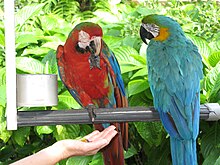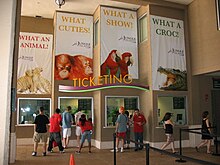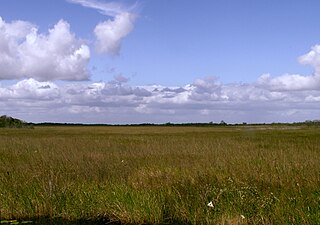
The Everglades is a natural region of flooded grasslands in the southern portion of the U.S. state of Florida, comprising the southern half of a large drainage basin within the Neotropical realm. The system begins near Orlando with the Kissimmee River, which discharges into the vast but shallow Lake Okeechobee. Water leaving the lake in the wet season forms a slow-moving river 60 miles (97 km) wide and over 100 miles (160 km) long, flowing southward across a limestone shelf to Florida Bay at the southern end of the state. The Everglades experiences a wide range of weather patterns, from frequent flooding in the wet season to drought in the dry season. Throughout the 20th century, the Everglades suffered significant loss of habitat and environmental degradation.

Bonita Springs is a city in Lee County, Florida, United States. The population was 53,644 at the 2020 census, up from 43,914 at the 2010 census. It is part of the Cape Coral-Fort Myers, Florida Metropolitan Statistical Area, on the state's southwest coast.
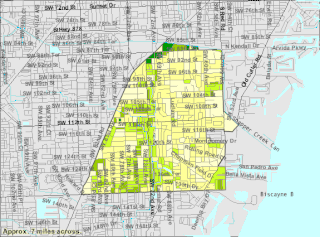
Pinecrest is a suburban village in Miami-Dade County, Florida, United States. The village is part of the Miami metropolitan area of South Florida. As of the 2020 census, the population was 18,388.

Biscayne National Park is a national park of the United States located south of Miami, Florida, in Miami-Dade County. The park preserves Biscayne Bay and its offshore barrier reefs. Ninety-five percent of the park is water, and the shore of the bay is the location of an extensive mangrove forest. The park covers 172,971 acres and includes Elliott Key, the park's largest island and northernmost of the true Florida Keys, formed from fossilized coral reef. The islands farther north in the park are transitional islands of coral and sand. The offshore portion of the park includes the northernmost region of the Florida Reef, one of the largest coral reefs in the world.

Everglades National Park is a national park of the United States that protects the southern twenty percent of the original Everglades in Florida. The park is the largest tropical wilderness in the United States and the largest wilderness of any kind east of the Mississippi River. An average of one million people visit the park each year. Everglades is the third-largest national park in the contiguous United States after Death Valley and Yellowstone. UNESCO declared the Everglades & Dry Tortugas Biosphere Reserve in 1976 and listed the park as a World Heritage Site in 1979, and the Ramsar Convention included the park on its list of Wetlands of International Importance in 1987. Everglades is one of only three locations in the world to appear on all three lists.
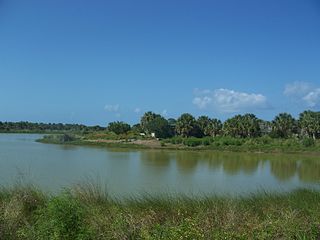
Pelican Island National Wildlife Refuge is a United States National Wildlife Refuge (NWR), and part of the Everglades Headwaters NWR complex, located just off the western coast of North Hutchinson Island in the Indian River Lagoon east of Sebastian, Florida. The refuge consists of a 3-acre (12,000 m2) island that includes an additional 2.5 acres (10,000 m2) of surrounding water and is located off the east coast of Florida of the Indian River Lagoon. Established by an executive order of President Theodore Roosevelt on March 14, 1903, Pelican Island was the first National wildlife refuge in the United States. It was created to protect egrets and other birds from extinction through plume hunting. The oldest government wildlife refuge of any kind in North America is the Lake Merritt Bird Refuge in Oakland, California. Oakland Mayor Samuel Merritt declared it a wildlife refuge for migrating birds in 1869. In 1870, the state of California designated Lake Merritt a state game refuge.

Watson Island is a neighborhood and man-made island in Biscayne Bay, in Miami, Florida. It is located Immediately east of the Central Business District and Arts & Entertainment District neighborhoods of downtown Miami and is connected to the mainland and South Beach, Miami Beach by the MacArthur Causeway.

The Arthur R. Marshall Loxahatchee National Wildlife Refuge is a 145,188-acre (587.55 km2) wildlife sanctuary is located west of Boynton Beach, in Palm Beach County, Florida. It is also known as Water Conservation Area 1 (WCA-1). It includes the most northern remnant of the historic Everglades wetland ecosystem.

Sarasota Jungle Gardens is a tourist attraction located in Sarasota, Florida, United States since 1939. The gardens contain over 10 acres (4.0 ha) of botanical plantings along with bird and animal shows. It is open to the public for a per-use ticket fee and also offers yearly membership passes.

Flamingo Gardens is a 60-acre (24 ha) botanical garden and wildlife sanctuary, located just west of Fort Lauderdale, Florida and north of Miami at 3750 South Flamingo Road, Davie, Florida, United States. It is open to the public for a fee.

Discovery Island is an 11.5-acre (4.7 ha) island in Bay Lake, Florida. It is located on the property of Walt Disney World in the city of Bay Lake. Between 1974 and 1999, it was an attraction open to guests, who could observe its many species of animals. Disney originally named it Treasure Island, and later renamed it Discovery Island. It currently sits abandoned, but can be seen by any watercraft in Bay Lake. Discovery Island is now the name of one of the lands in Disney's Animal Kingdom.

The Miami-Dade Zoological Park and Gardens, also known as Zoo Miami, is a zoological park and garden in Miami and is the largest zoo in Florida. Originally established in 1948 at Crandon Park in Key Biscayne, Zoo Miami relocated in 1980 as Miami MetroZoo to the former location of the Naval Air Station Richmond, southwest of Miami in southern unincorporated Miami-Dade County, surrounded by the census-designated places of Three Lakes (north), South Miami Heights (south), Palmetto Estates (east) and Richmond West (west).

The St. Augustine Alligator Farm Zoological Park is one of Florida's oldest continuously running attractions, having opened on May 20, 1893. It has 24 species of crocodilians, and also a variety of other reptiles, mammals and birds, as well as exhibits, animal performances and educational demonstrations.

Pinecrest Gardens is a 20-acre (81,000 m2) park in Pinecrest, Florida on the corner of Southwest 111th Street and Southwest 57th Avenue.
There are a number of environmental issues in Florida. A large portion of Florida is a biologically diverse ecosystem, with large wetlands in the Everglades. Management of environmental issues related to the everglades and the larger coastal waters and wetlands have been important to the history of Florida and the development of multiple parts of the economy of Florida, including the influential agricultural industry. This biodiversity leaves much of Florida's ecological ecosystem vulnerable to invasive species and human sources of industrial pollution and waste.

An ongoing effort to remedy damage inflicted during the 20th century on the Everglades, a region of tropical wetlands in southern Florida, is the most expensive and comprehensive environmental repair attempt in history. The degradation of the Everglades became an issue in the United States in the early 1970s after a proposal to construct an airport in the Big Cypress Swamp. Studies indicated the airport would have destroyed the ecosystem in South Florida and Everglades National Park. After decades of destructive practices, both state and federal agencies are looking for ways to balance the needs of the natural environment in South Florida with urban and agricultural centers that have recently and rapidly grown in and near the Everglades.

Tropical hardwood hammocks are closed canopy forests, dominated by a diverse assemblage of evergreen and semi-deciduous tree and shrub species, mostly of West Indian origin. Tropical hardwood hammocks are found in South Florida or the Everglades, with large concentrations on the Miami Rock Ridge, in the Florida Keys, along the northern shores of Florida Bay, and in the Pinecrest region of the Big Cypress Swamp.

Everglades Alligator Farm is a wildlife park in Miami-Dade County, Florida, nearby the city of Homestead and the entrance of Everglades National Park. It claims to be the oldest and largest alligator farm in South Florida, along with containing over 2,000 alligators. Additionally, it provides airboat rides through the Floridian wilderness.


